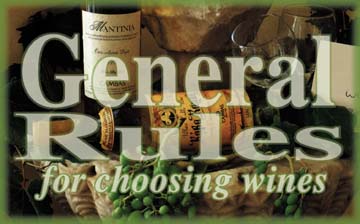
Most often choosing wine is dictated by personal taste or the
pocketbook. over the centuries, certain rules of taste have been established to guide the
wine drinker in selecting the proper wine for the occasion, or to go with certain foods.
even with changing times, the following rules still guide tastes:
Above all, personal taste is the most important thing. Let us analyze the food and wine
compliments a little closer.
Wine Enemies
Wine enemies are vinegar (watch for vinegary salads) and acids such as grapefruit,
oranges, lemons and melons. Also such pungent things as onions and garlic, over emphasized
spices, curry and some mustards can also have an effect on the harmony of wine and food.
Therefore, it is advisable to know what effects the enemies will have.
Aperitifs
National tastes are most marked in choice of aperitifs. The ideal aperitif stimulates the
appetite as well as the wits. It is brisk and dry, with either a sparkle, e.g. sparkling
wines, champagne’s, or a tang, e.g. vermouth, dry sherry and may dry white wines make
perfect drinks before dinner and are gaining in popularity.
Hors D'Oeuvre
We could finish our sherry, or have another glass of the same with most of the courses we
start our meal with ie. artichoke, avocado, tomato salad, smoked fish, eggs, pates,
melons, etc. A first glass of the wine you intend to have with your meal may also fit
well.
Dry white wines are the best with shellfish appetizers. All meaty and savory hors
d’oeuvres are fine with an ordinary red or rose wine.
If there are enough people to drink more than one bottle with a meal, it makes things more
interesting to have different wines with the hors d’oeuvres and the main course.
Soups
Wine normally does not go with soups (except onion soup and minestrone) but in soups,
particularly Madeira and Sherry in clear soups. The same wines are good sipped with most
soups.
Pastas
The obvious thing is to drink Italian red wines with pasta. Pasta and Chianti are
inseparable. Quiche Lorraine is preferred with a white Alsace wine.
Fish
All fish call for white wines. Fish with considerable flavour, either in its flesh or
sauce, and shellfish are best accompanied by fairly rich flavoured wines, usually white
burgundies. Moselles and faire wines go well with river fish.
Watched methods of preparation, a young, fresh, more northern wine will fit Truite au
Bleu, while a warmer flavoured, more assertive wine would go well with Truite Meuniere.
Beef
Red wines are the obvious choice as a rule. Choose darker wines for darker cuts of meat,
good or great Bordeaux or Burgundy wines with roasts, lesser red wines with stews.
Chicken
Chicken is the most versatile of all dishes as far as wine is concerned, everything
depends on the way the chicken is cooked. A Coq Au Vin, where the Vin is Chambertin, calls
for a glass of Chambertin beside it. However, you can cook chicken in a way to perfectly
compliment almost any wine.
Game
Game birds are committed red wine dishes. A simple rule is to drink good red Bordeaux with
unhung game such as partridge, grouse, snipe or quail. Good red burgundy with any game
which has been hung.
Burgundy with game pie, and either Chateauneuf du Pape, strong and soft flavoured, or
Rhine wine with duck or goose - birds which need their fat counter balanced.
Cheese
Earthy and tangy cheese demands hearty red wines. Fresh cheeses are well suited to dry,
light wines, the greater the fat content, the better the cheese will do with subtle wines.
Many of the best combinations of wine and cheese are closely related by region of origin.
Robust, full bodied, strong red wines from all regions, and Port with Roquefort, Stilton
and Gorgonzola. Fine red wines for full bodied, dry white wines for soft ie. Camembert,
Brie, Belpaese, Port Salut. Dry fruit wines, red and white for Emmenthal, Gruyere, Gouda
an Edam. Light red wines and medium dry white wine
for fresh cream cheeses, Boursault, Gervois, Philadelphia Cream, etc.
Fairly robust, dry red wines for semi-hard cheeses, smoked, covered with nuts, dried black
grape skins, etc.
Sweets
As a general rule, wines are not desirable with sweet dishes, since it is rare to find the
kind or perfect match between food and wines. Diversions of cake, strawberries,
raspberries, peaches, or apricots, pastries and cream are delicious with the heavier kind
of sweet wine, or a champagne.
In connection with these remarks, a special place for champagne must be
made, for it is a beverage so unique. It deserves a special remark. Champagne has the
stimulating qualities of an aperitif. It owes a large part of its reputation to its
magical effect on the moral. Champagne can accompany any and all food, but you would not
do it justice if you choose it only in the first spirit of compromise.....